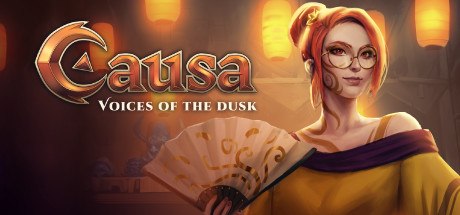When players are the content you need more players
Type: Singleplayer, Multiplayer
Genre: Tactical Card Battler
Developer: Niebla Games
Publisher: Niebla Games
Release date: 26 May, 2021


In 1993 Richard Garfield launched a little known game called Magic the Gathering. It became a smash hit, and in the years following TCGs (Trading card games) exploded, with all kinds of weird and mostly not so wonderful games getting released. This wild west time of TCGs saw a lot of ideas being put into print, from the “We don’t need to balance our cards” approach of Galactic Empires, to the garish and not very well thought out SimCity that just did not work with 2 players (and hardly even with 3 or 4) to the cutthroat diplomacy of the Babylon 5 TCG (which was really good). But since then the TCG genre seems to have calmed down, and certain mechanics have become commonplace, while others have fallen to the wayside. Hearthstone would then, in 2014 cement what a digital TCG should be like.
Causa, Voices of the Dusk is a post-Hearthstone TCG, borrowing a lot of its visual design from Blizzard’s smash hit, while putting its own twist on the well trodden TCG mechanics seen in many of the recent digital TCGs. The TCG market is highly competitive and many games fail to sustain much of an audience. Can Niebla Games succeed where giants such as Ubisoft, Bethesda & Valve failed?
Presentation
The first impression Causa gives is pretty good. You get thrown into a tutorial and get to see what the game looks like right away, and it looks pretty good. The card art is well drawn and consistent, the main character representing you is animated, but not over-animated and the backgrounds are nice. Cards are easy to read and all the relevant information is presented in a clear way. Effects are show when you do most things, like attacking, using cards and so on, and the effects are pretty good, fitting in with the aesthetic of the game and never go overboard. The same clear design continues with the main menu, and while some of the sub-menus, like the one showing your collection of cards, can feel a little bit cluttered, it’s still never hard to read. Speaking of card management, there’s good sorting options for when checking your collection or building a new deck that makes it easy to find roughly what you’re looking for, without having to dig through piles of cards that are not relevant to you.
Most of the creatures and characters in Causa are if not realistic, at least grounded in reality. There’s no dragons or other really fantastical beasts, and most of the cards depicts humans or animals, though there’s still a hint of fantasy to the setting the cards depict, though it rarely gets more fantasy-like than what’s seen in the tutorial.
The sound design is also good. Sound effects help reinforce what’s going on, and make card effects feel more impactful without feeling distracting and the background music that’s played during matches is pleasant. It works well as background music.
Overall Causa both looks and sounds nice. It might not be quite on par with say MTG Arena, but it’s not too far from it, and the art style on the cards is more consistent than that of Magic the Gathering. The animations does make it stand out when compared some other TCGs made by smaller studios and overall the production value does feel like it’s almost on par with that of some of the giants of the genre.
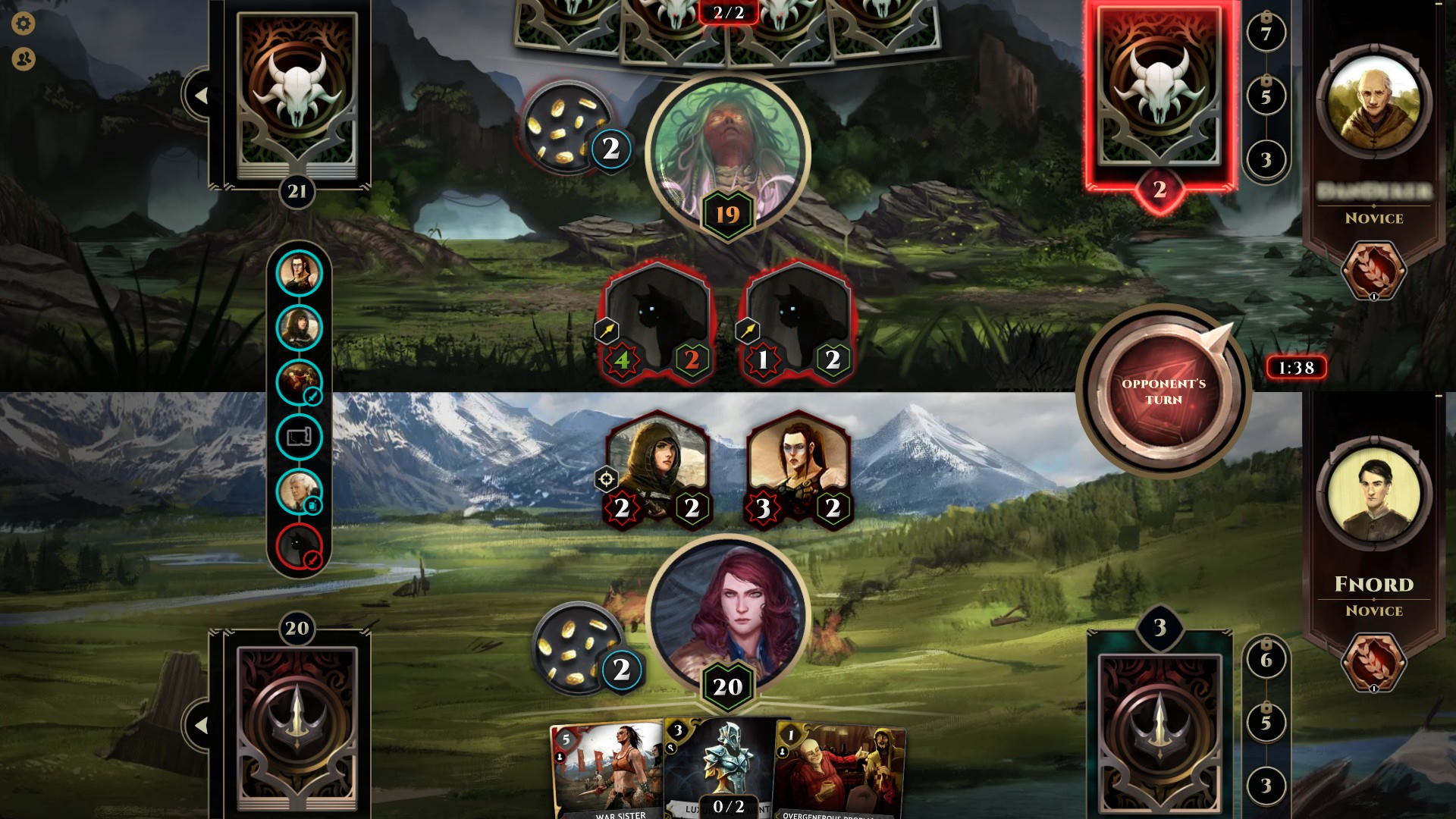
Gameplay
As with many other TCGs the goal of Causa is to get the opponent’s health down to 0. Both players start with 20 health, and you hurt the enemy by attacking with your creatures and playing cards that deal damage, or by getting the opponent’s deck down to 0 cards, at which point they’ll start taking damage when they need to draw cards at the start of their turn.
A turn in Causa works like this: You start by drawing cards. If you have less than 4 cards in your hand you draw enough cards that you have 4, and if you have 4 you draw a single card. Then you get to play cards and use your creatures. Every card has a “rank”, and in order to be able to play cards of a higher rank you need to put a card aside. Creature cards that are in play can be put aside, so you don’t have to use cards from your hand to do it, but you can only put one card aside every turn, and you can play cards of a rank equal to or under the number of cards you have put aside. A maximum of two cards can be played every turn unless you’ve got some effect that lets you play more.
Cards come in a few different variants, characters (creatures) which are permanent (until they die), events, which are one-time effects that happen as soon as the card is played, and support, which gives you a token that can be activated whenever you want, during your turn, and which usually has an immediate effect similar to an event. Some support cards have multiple uses, or even permanent passive effects and there are other cards that can interact with them.
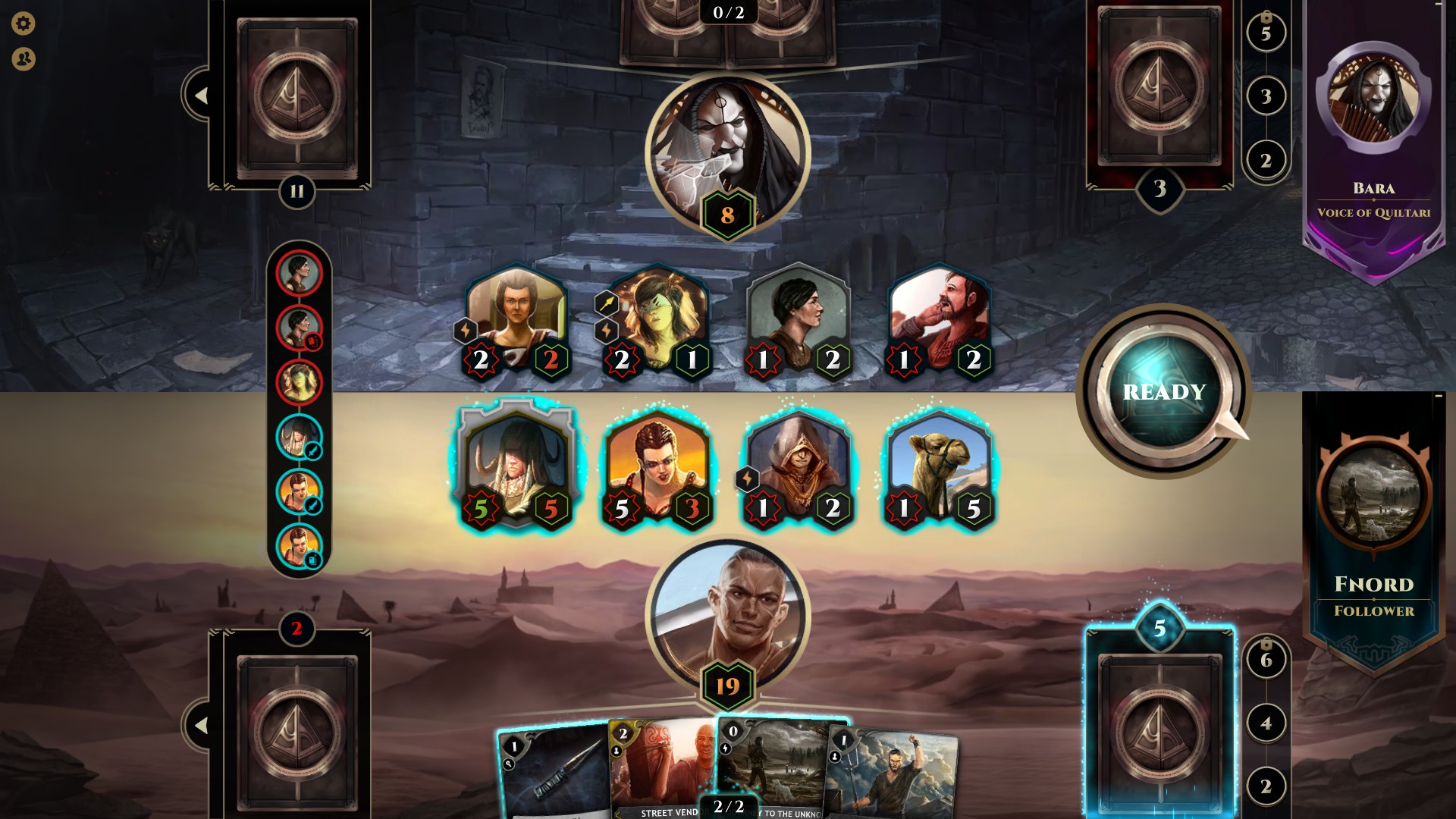
Similarly to many other TCGs creatures that are played can’t attack the turn they appear, unless there’s some effect that says that they can, similar to Haste in Magic the Gathering. When attacking with a creature it’s the attacker that chooses target, and they can choose to either attack an opposing creature, or the opponent, though a few creatures are more defensive in nature and if one of those are in play it needs to be attacked first. As is the norm creatures have two stats, one for how much damage they deal, and one for how much damage they can take. When a creature attacks another creature or is attacked both sides deal damage to each other at the same time. If a creature reaches 0 health it dies and is removed from the board.
All of this should sound quite familiar to anyone playing TCGs for a while, and the main thing that sets Causa apart is how the casting cost, that is the price you need to play for playing a card, is handled. You don’t expend any resource when playing cards, instead the number of cards you’ve put aside is how much a card is allowed to “cost”, so you can play two cards that has a rank of 5 in the same turn if you’ve set aside five cards. What does make this system a bit more interested is that any cards you’ve set aside can still be played. They’ll then enter the board and act as any other card, but you’ve now got one less card set aside. This system is the main strength of Causa, it prevents high cost cards drawn early from being deadweight in your hand, as you can set those aside early. Also unlike with systems that have explicit energy/mana generating cards, like Magic the Gathering, you’ll never “flood out” (draw far too many mana generating cards) or have droughts (draw far too few), so you’ll be able to do something every turn.
Matches in Causa are usually pretty short, usually less than 10 minutes in length and the starting health of 20 can go down really fast. The fact that you draw up to a hand of 4 cards at the start of every turn also mean that they can very quickly change, one person might look like they’re at an advantage but the next turn the other person gets four new cards and can defend themselves or wipe the opponent’s board. A bad start is not as crippling as in most other TCGs, and it’s easier to make a comeback from an unfavourable situation than is the norm.
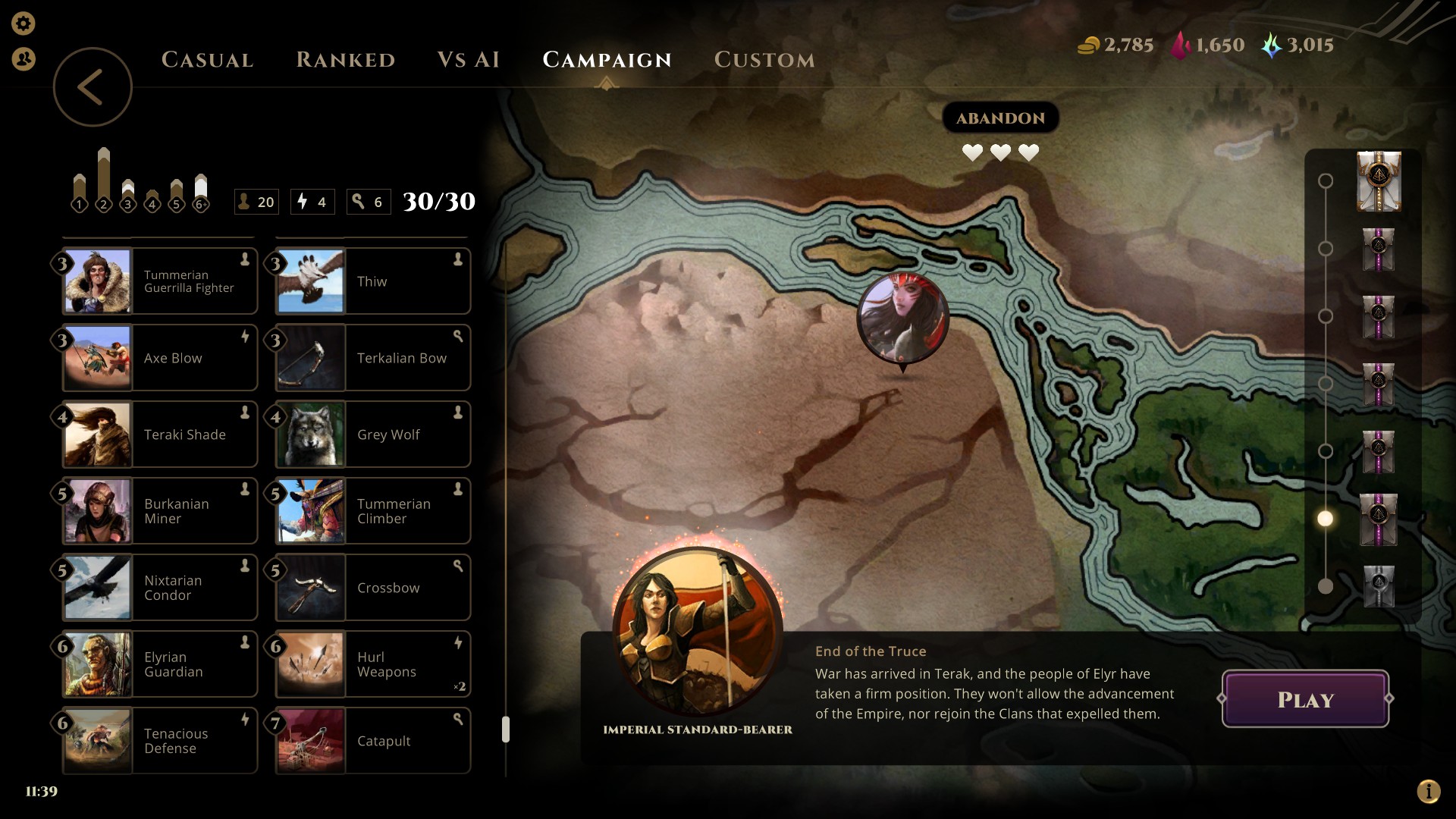
There are a few different game modes that all pretty much boil down to playing a game of Causa. Ranked, Unranked and vs. AI are the same, apart from the obvious difference that vs. AI will be against a computer, and ranked will add to your rank. Then there’s campaign, which is a draft mode vs. the AI. You can, at the time of writing, pick between three different campaigns, and they’re played out in a draft format, that is you’re given a set of cards to choose from, pick a limited number of those, then the rest gets discarded and you get a new set of cards to choose from, repeat this until you’ve got a full deck. Then you play through a series of matches against the AI with your newly formed deck until you’ve won.
The AI is overall pretty toothless. While it understands how to do most basic things, like attacking, targeting the most dangerous creature and so on, it’s not good at playing around special effects. For an example if you have a creature in play that forces the enemy to discard cards from its deck whenever they play an event, the AI will still happily play events until it has no cards left in its deck. Players are of course better at reading the board, but herein lies another problem: The playerbase. At the time of writing there’s not a whole lot of players online. The game is not dead, but the playerbase is small, and many of these players are people who have played for some time during early access, meaning that they’ve had time to build up strong decks and know the inns and outs of the game. As a new player this is a rather hostile environment to play in. The free starter decks you get (you don’t actually get the cards in them, you just get to use the decks) are not really up to the task when it comes to playing against the decks that people have made either. They function, and show a few different playstyles, but they’re woefully underpowered compared to the deck a somewhat experienced, or heck even a somewhat inexperienced player has put together.
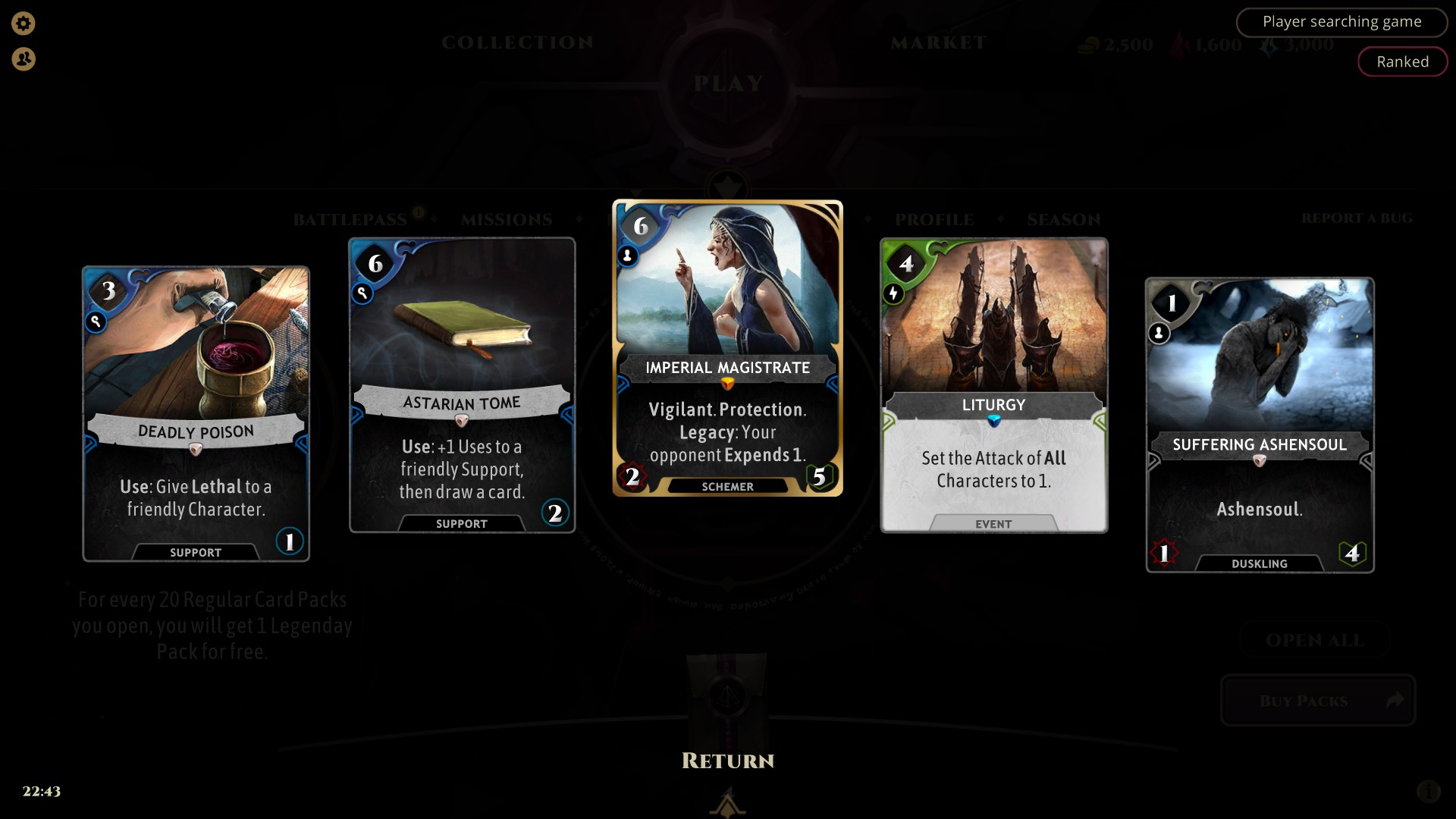
Deckbuilding
Building a deck is of course an integral part of any TCG, and Causa is no exception. First thing you need to do when building a deck is choosing a main character for it. Each main character has one or two colours associated with it, and once you reach certain thresholds for number of cards set aside you’ll get to choose between two different effects. Both the exact thresholds and the effects differ from character to character, so picking a character that fits what you have in mind for your deck is important. At the moment there are not a whole lot of different characters to choose from, and all multi-coloured ones needs to be paid for, so you’ve got a single-coloured one for each of the four main colours. Each colour represents a theme, Glory, Wealth, Influence and Spirit, and have cards that in some way fit in with that theme. Influence for an example tends to be a bit more on the subtle side, and likes to mess with your opponent, while Glory enjoys smacking the opponent with big creatures.
Each deck is made up of 30 cards, and you can’t have more than 2 of any one card in your deck. All the cards in the deck also needs to be of the colour of your character, or neutral. Beyond that you can build your deck pretty much however you want, though you probably want to have a smooth curve for the “cost” of your cards, and you want cards that work well together and are able to build upon each other’s effects. Forcing the opponent to discard one card from their deck for an example will hardly have any effect on the game, but if you have lots of cards that forces them to do this you can make them run out of cards quickly.
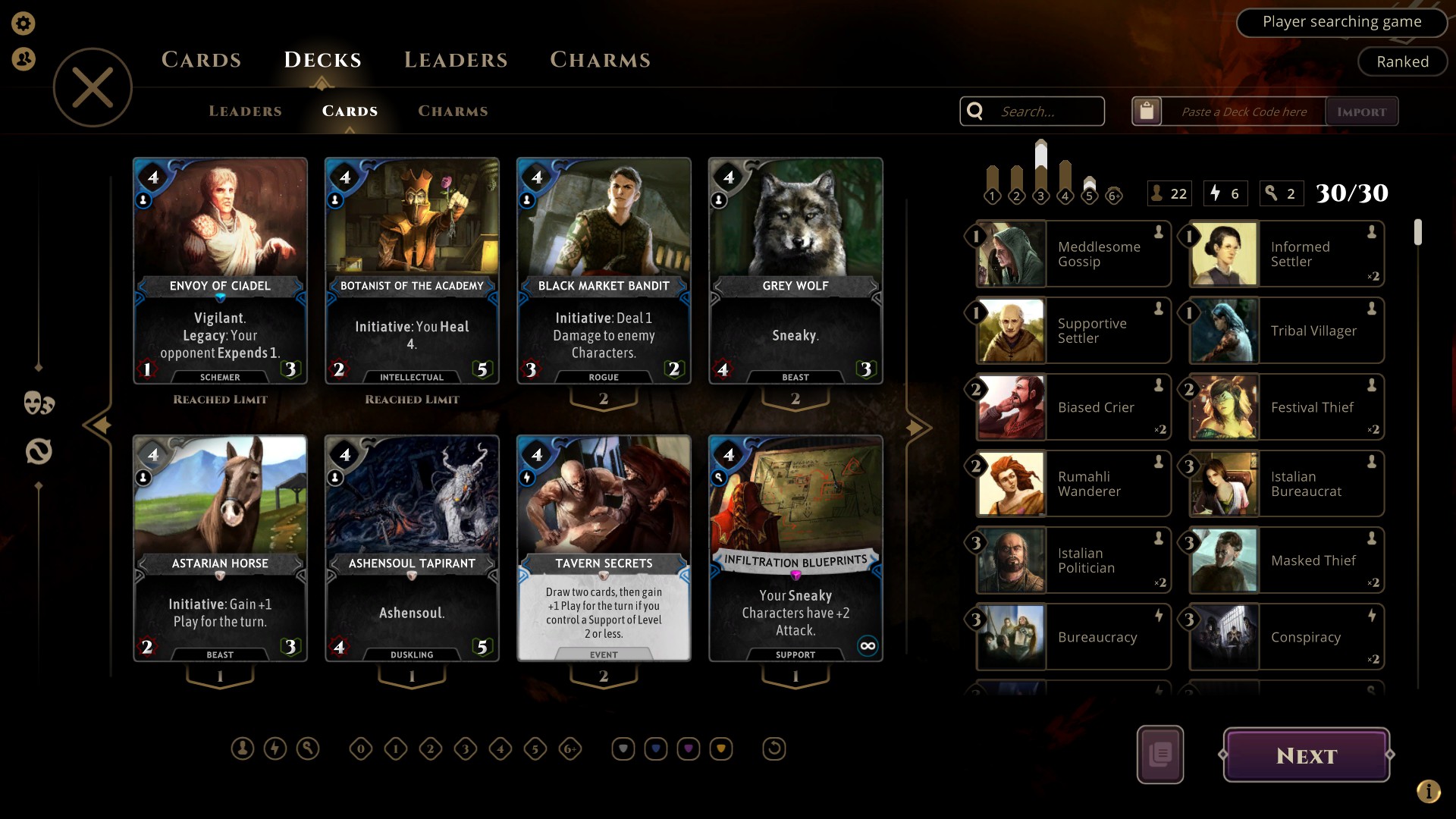
Monetization
Games need to make money, and TCGs tend to do that by selling you card packs. Causa is no exception. Card packs contains 5 cards and costs 200 “organite”, the premium currency of this game, 750 organite costs $5. That will conveniently enough give you enough for 3 packs of cards, and then 150 to spare, so just a little bit less than what’s needed for a 4th pack. This is a common tactic among free to play games, give uneven quantities of the premium currency to encourage further spending. There’s also a $10 battle pass as well as new characters and cosmetic stuff like card backs. For new characters the ones that allow you to build multi-coloured decks are more expensive than the single-coloured ones.
There are ways to earn currency in-game, and all non-cosmetic things can be bought with the free in-game currency. You get a small amount of in-game currency for winning a match in multiplayer, as well as doing daily quests. The game is not too stingy with giving free stuff early on, but the fact that you need to win in order to earn the in-game currency, beyond what you get for daily quests, is a bit of a problem due to the games small but invested playerbase. It’s hard to start winning unless you’ve already got a good deck, and the freebies slow down after a while. The game is more generous with the freebies than say Hearhtstone, but the small playerbase once more becomes an issue as it’s harder to play with just what you get for free due to there not being many other players who just use the starter decks.
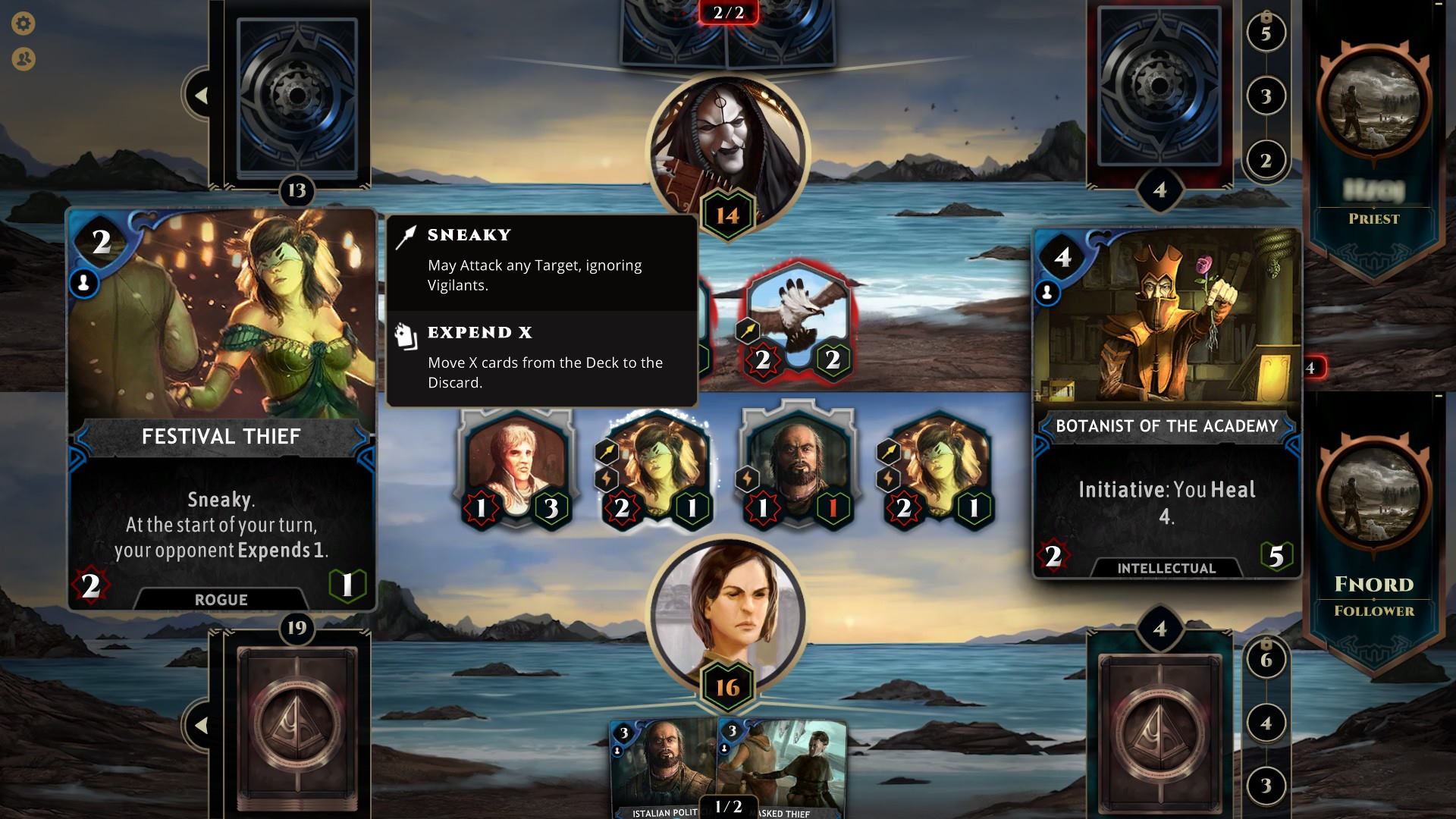
Closing Thoughts
Causa is a solid TCG, but it fails to really innovate. Apart from the resource mechanic, which is not entirely unique to this game, there’s little new here, and it’s game that plays it very safe with its mechanics. That does mean that anyone coming in from Hearthstone, Elder Scrolls Legends or most other post-Hearthstone digital TCGs won’t have a hard time learning the game, but on the other hand it’s going to be hard for Causa to convince anyone who’s already invested in another TCG to try something so similar. It’s free, so there’s no harm in downloading it and giving it a shot, but for me personally Causa just failed to have that special something that would make me chose this over one of the many other games of its type, and the small playerbase does make it a pretty tough game to get into.

